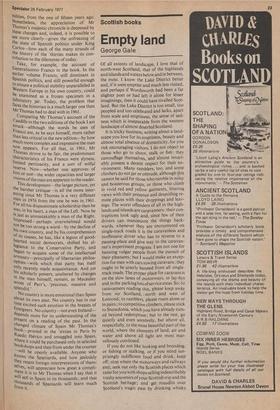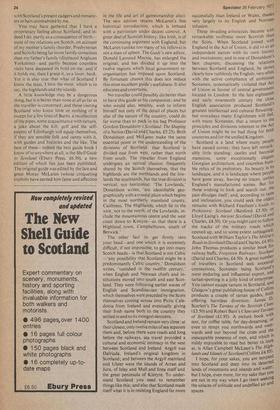Scottish books
Empty land
George Gale
Of all extents of landscape, 1 love that of north-west Scotland, that of the highlands and islands and waters below and in between, the most. I know the Lake District better and, if it were emptier and much less visited, and perhaps if Wordsworth had been a far slighter poet or had left it alone for lesser imaginings, then it could have rivalled Scotland. But the Lake District is too small, too peopled and too celebrated and lacks, apart from scale and emptiness, the sense of sadness which is inseparable from the western landscape of almost deserted Scotland.
It is tricky business, writing about a landscape you love for its emptiness, beauty and almost total absence of domesticity, for you risk encouraging visitors. I do not object to those who go to shoot, stalk or fish : they camouflage themselves, and almost invariably possess a decent respect for their environment. Many ramblers, too, and some climbers do not jar or obtrude, although this cannot be said for those who ramble in noisy and boisterous groups, or those who climb in vivid red and yellow garments,,littering views with their presence and despoiling remote places with their droppings and leavings. The worst offenders of all in the highlands and islands are caravanners: their contraptions look ugly and, since few of their drivers can manoeuvre the things backwards, whenever they are encountered on single-track roads it is the caravanless and inoffensive driver who has to reverse to a passing-place and give way to the caravanner's impertinent progress. I am not one for banning vulgar people from the pursuit of their pleasures; but I would make an exception for men with cars towing caravans : they ought to be utterly banned from all singletrack roads.The proper place for caravans is on the slow lanes of motorways, in lay-bys and in the parking lots of service areas. So: to caravanners reading this, please keep away from my Scotland, north and west of Lomond; to ramblers, please roam alone or in pairs ; to competitive climbers, please stick
to Snowdonia, which you have already ruined beyond redemption; but to the rest, go quietly and even sombrely, but above all, respectfully, to the most beautiful part of the world, where the elements of land, air and water and above all light are most marvellously combined.
If you do not like looking and brooding, or fishing or stalking, or if you mind sur prisingly indifferent food and drink, keep
off; stop where the motorways and railways end; seek out only the Scottish places which
cater for you with shops selling indescribably trashy souvenirs of your Scottish trip and the Scottish heritage; and get maudlin over Scotland's tragic past by drinking whisky with Scotland's present cadgers and romancers in bars uninhabited by me.
You may have gathered that I have a proprietary feeling about Scotland; and indeed I do, partly as a consequence of birth— most of my relations are Scotch, on account of my mother's family (border, Presbyterian and Scotch) being far more family-conscious than my father's family (displaced Anglican Yorkshire)— -and partly because countless visits have deepened its hold on me: and if it holds me, then I grasp it, as a lover, back. Yet it is also true that what of Scotland I know the least, I love the most, which is to . say, the highlands and the islands.
• A little knowledge may be a dangerous thing, but it is better than none at all as far as the traveller is concerned; and those visiting Scotland who know little or nothing of it except for a few lines of Burns, a recollection of the pipes, some acquaintance with tartans, a joke about the kilt, golf and the selfesteem of Edinburgh will equip themselves, if they are sensible folk and canny with it, with guides and histories and the like. The best of these— indeed the best guide book I know of to anywhere at all, is the Shell Guide to Scotland (Ebury Press, f6.50), a new edition of which has just been published. The original guide was edited by the late and great Moray McLaren (whose croqueting exploits have earned him fame and affection in the life and art of gamesmanship also). The new edition retains McLaren's fine historical introduction, which is imbued with a patriotism under decent control. A great deal of Scottish history, like Irish, is of the continuing argument with England, but McLaren (unlike too many of his fellows) is not a man of spleen. The Guide's new editor, Donald Lamond Macnie, has enlarged the original, and has divided it up into the twelve regions which local government reorganisation has imposed upon Scotland. By fortunate chance this does not reduce this most excellent guide's usefulness. It also educates and entertains.
No traveller could possibly do better than to have this guide as his companion; and he who would also, sensibly, wish to inform himself not only of.the detail of places but also of the nature of the country, could do far worse than to pack in his bag Professor Gordon Donaldson's Scotland: The Shaping °fa Nation (David and Charles, f5.25). Both Donaldson and McLaren make the same essential point in the understanding of the divisions of Scotland: that Scotland is divided east from west, rather than north from south. The traveller from England undergoes an optical illusion, frequently shared by the Scotch themselves, that the highlands are the northlands and the lowlands the southlands, but the true division is vertical, not horizontal: 'The Lowlands,' Donaldson writes, 'are identifiable geographically with a coastal plain which begins in the most 'northerly mainland county, Caithness. The Highlands, which lie to the west, not to the north, of the Lowlands, include the mountainous centre and the west coast down to Kintyre—so that there is a Highland, town, Campbelltown, south of Berwick.'
The other fact to get firmly into your head—,and one which it is extremely difficult, if not impossible, to get into many Scotch heads—is that Scotland is not Celtic —`any possibility that Scotland might be a predominantly Celtic country,' Donaldson writes, 'vanished in the twelfth century,' when English and Norman chiefs and institutions moved into south and east Scotland. They were following earlier waves of English and Scandinavian immigration, which themselVes were preceded by the Scots themselves coming across into Pictic Caledonia from Ireland and eventually giving their Irish name both to the country they settled in and to its mongrel denizens.
Scotland and Ireland remain very close: at their closest, only twelve miles of sea separate them and, before there were roads and long before the railways, sea travel provided a cultural and economic intimacy in the west between Scotland and Ireland. Argyll was Dalriada, Ireland's original kingdom in Scotland; and between the Argyll mainland and Ulster were the islands of Arran and Jura, of Islay and Mull and lona itself and the great peninsula of Kintyre. To understand Scotland you need to remember things like this; and also that Scotland made itself what it is in resisting England far more successfully than Ireland or Wales, thanks very largely to its English and Norman in
These invading aristocrats became with remarkable swiftness • more Scottish than the Scots. When Scotland joined with England in the Act of Union, it did so as an independent nation with its own historY and institutions; and in one of Donaldson 's best chapters, discussing the relations between Scotland and England, he shows clearly how ruthlessly the English., very often with the active 'compliance of ambitious Scotsmen, systematically violated that Act of Union in favour of central government located in London. In the late eighteenth and early nineteenth century the close English association produced Scotland's greatest intellectual and cultural flowering; but nowadays many Englishmen will feel, with many Scotsmen, that a return to the principles and divisions inherent in the Act of Union might be no bad thing for both countries and for the unified K ingdom • Scotland is a land where many peoPle have passed across; they have left remarkably little standing: castles and baronial mansions, some exceptionally elegant Georgian architecture, and countless humble relics of its prehistory. Its beauty is its landscape, and it is landscape where people have gone away, leaving no traces, unlike England's manufactured scenes. But for those wishing to look and search out, the past divulges itself; and, according to taste and inclination, you could seek the oldest remains with Richard Feachem's Guide to Prehistoric Scotland (Batsford £5.50) or Lloyd Laing's Ancient Scotland (David and Charles, f4.50). Or you might care to follow the tracks of the military roads which opened up, and to some extent subjugated. Scotland with William Taylor's The Roads in Scotland( David and Charles, John Thomas produces a similar book for railway buffs,-Forgorte.ri Railways: Scotland (David and Charles, £4.50). A great number of travellers in Scotland seek ancestral connections, Scotsmen being Scotland's most enduring and influential export, and tartan-spotting is a jolly kind of enterprise. You cannot escape tartans in Scotland, and Glasgow's great publishing house of Collins produces a couple of tartan guides, both offering harmless diversion: James D. Scarlett's The Tartcins of the Scottish Clans (B.50) and Robert Bain's Clans and Tartans of Scotland al .95). A picture book with text, for coffee table, for day-drearning, or even to tempt you northwards and westwards and out beyond the cities and the inescapable presence of men, and which is mildy enjoyable to read but better tb look at, is Allan Campbell tvIgLean's The High' lands and Islands of Scotland (Collins f4.95). I hope, for your sakes, you are tempted into Scotland and deep into its deserted lands of mountains and islands and water; but I hope, even more, for my sake that you are not in my way when I go there seeking the solaces of solitude and undefiled air and spaces:



































 Previous page
Previous page